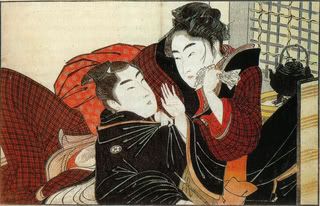
kitagawa utamaro, the pillow book, 1788
nuh n’shkoo
in tokugawa japan, the era before admiral perry forced japan to open up to international trade (1603-1868), what westerners now call bisexuality was the norm. ‘nanshoku,’ or ‘allure of men,’ literally ‘male colors,’ was a man’s attraction to other men.
nanshoku refers to a certain form of sexual pleasure (for men) + the practices that produce it, rather than to a moral or psychological category of persons.
pre-19th-century japanese painting + poetry portray ‘male colors’ on equal footing with ‘female colors.’
before western influences began to displace much of japanese culture, nanshoku thrived in urban, monastic, + samurai cultures—for example, spartan-like mentorship + pederasty were crucial to samurai training.
male-male affection was not only open but also integrated into social institutions in japan for over 250 years, longer than any comparable acceptance of homosexuality at any point in history anywhere in the world.
japanese men of this era tended to idealize androgyny—except for genitalia, tokugawa japanese saw male + female bodies as practically identical, so dress, makeup, + behavioral norms were similar.
however, men also sometimes favored the ‘roughneck’ (‘koha’) as an ideal male type, much as ‘rough trade' had (+ has) fans in america.
homophobia entered japan along with other western influences at the end of the 19th century. unlike in europe, though, in japan same-sex love co-existed, however uneasily, with christianity, whose first missionaries arrived about 50 years before the tokugawa era began.
No comments:
Post a Comment